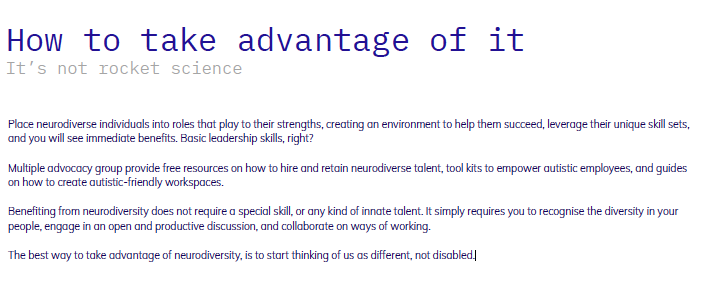The speaker of this talk was Ben Jackson who discovered his Autism Spectrum Disorder as an adult.
I found this to be a great talk. I was deeply inspired by Ben’s self-knowledge, his investment in self discovery, his courage in getting up on the big stage in the largest meeting room at Product Camp and his commitment to shining a light on the spectrum of his own humanity.
The focus of the talk was Ben’s own experience and his own neurodiversity. He was not seeking to convey the experiences of other neurodiverse people. Instead Ben wanted to give us an idea of what it is like to be neurodiverse
It is impossible for Ben to put words to the thousands of things he struggles against every day but he did share his self-stimulating (‘stimming’) behaviours that help him focus and are part of his self-management.
Two of the key terms Ben used were “neurodiverse” and “neurotypical”. Neurodiversity refers to variations regarding sociability, learning, attention, mood & other mental functions. Autistic Spectrum Disorder, Dyslexia & Attention Deficit Hyperactivity Disorder are some of the variations. Neurotypical is used to describe individuals of typical developmental, intellectual & cognitive abilities.
Key take-aways from the talk
Neurodiversity is a spectrum, not where someone sits on a 1-10 scale
A neurotypical person can be represented on the colour wheel as an almost perfect circle whereas a neurodiverse person would be more like a 5 pointed star. The big thing to remember is each neurodiverse person is as unique in themselves as a neurotypical person is.
Triggers and reactions are not a choice
Neurodiversity can also mean diversity in triggers and reactions to specific stimuli.
For example, Ben can find unexpected social interaction a trigger that leads to stress. When stressed, he tends to bite nails, touch his face and repeatedly wring his hands. His stress reactions also include extreme perfectionism. He has a pathological need to complete a task and has no choice overdoing it. He has sensitivity to sudden loud noises and even colours can trigger discomfort or cause a panic attack.
Neurodiversity means strengths and challenges in a workplace
Like with all us humans, the challenge is to understand where our strengths lie and how to use it for good.
For Ben, it means he is excellent at pattern recognition. He is also completely honest yet won’t realise if he’s being offensive or hurtful even though he’s very afraid of causing emotional distress in others. He works ‘like a computer’ where if there’s any room for interpretation he freezes as directions. Questions should be very clear as he can anticipate thousands of variations you may need but won’t know which you need
How to work with an autistic person? Just like anyone else!
When you start working with a new person, it sometimes takes a little while & effort to understand how to work best with them. Same is true with someone who is neurodiverse. Sit down and work out a way you can work with them.
This is not hard, just slightly different. It is similar to how you travel to a new country and adapt to their culture.
Doing this is just a part of being a good leader and a good human being.

Where to learn more
Aspect Victoria https://www.autismspectrum.org.au/
AutismCRC https://www.autismcrc.com.au/
Ben’s article – Why you should care about Neurodiversity in the Workplace

